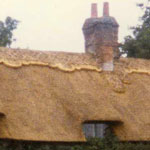Thatching Explained
Types of Thatch


 Most thatched properties that are listed must be thatched with the same material that was previously used. You may need planning permission for any job on a thatched property.
Most thatched properties that are listed must be thatched with the same material that was previously used. You may need planning permission for any job on a thatched property.
Long Straw
Long Straw is drum thrashed wheat straw prepared by hand. The straw is thrashed but not combed or combine harvested, and has a more ornate appearance with hazel spar work around the eaves to keep them secure.
Useful life of around 20-25 years
Combed Wheat
Combed Wheat is drawn from the same source as long straw but differs in the harvesting stage. Wheat straw is been passed through a reed comber, a modification of a thrashing drum to mechanically straighten and clean out the unwanted flag.
The finished bundle stands between 4 feet tall and has clean butts at the bottom which gives the roof a smoother appearance.
Useful life of around 30-35 years
Water Reed (Phragmites Australis)
Water Reed, more generally known as Norfolk Reed, is a coarser material grown in marshlands and stands much taller than straw, aprox 5-6 feet.
Water reed gives a sharper appearance when laid.
Useful life of around 40-50 years
Advantages of Thatch
- thermal insulation
- good acoustic insulation, making extremely quiet living conditions
- a thatched roof will ensure the house is warm in the winter and cool in the summer
- natural materials are more sustainable.
- the thatch does not need to be the exact dimensions to cover the structure and work to it's full potential.
- thatch works well on irregular roof structures.
- thatch has an ecological advantage as it is produced in a natural process and the natural materials used in thatching are improved by regular harvesting.
Care & Costs
 Unlike a conventional roof, it is very obvious if a thatched roof is in poor condition. Take your time to step back and look at the roof and if you can see any exposed fixings, this will indicate that the thatch is either nearing or is at the end of it's life span. If there are dark wet patches on the eave lines and close to the wall, this indicates that the thatch may be leaking. If the roof is covered in moss, the thatch may struggle to dry out properly, as it may not be able to "breath".
Unlike a conventional roof, it is very obvious if a thatched roof is in poor condition. Take your time to step back and look at the roof and if you can see any exposed fixings, this will indicate that the thatch is either nearing or is at the end of it's life span. If there are dark wet patches on the eave lines and close to the wall, this indicates that the thatch may be leaking. If the roof is covered in moss, the thatch may struggle to dry out properly, as it may not be able to "breath".
If Gullies start appearing, (vertical deep rotten patches), then they will require the attention of a thatcher.
Remember, it is best for even small repairs to be carried out by a professional thatcher. If you spot any problems, contact a professional thatcher and they will be able to help you further with all the information and advice you require.
Prompt action can prevent a bigger (more expensive) problem occurring.
Unfortunately we cannot give a set cost for repairs or services, as this depends on many factors.
- Size of the roof
- Access to the site and roof
- Height to eaves
- Height to ridge
- Shape and design of roof
- Types of features, and complexity
- Materials used
- Existing roof condition
- Roof preparation